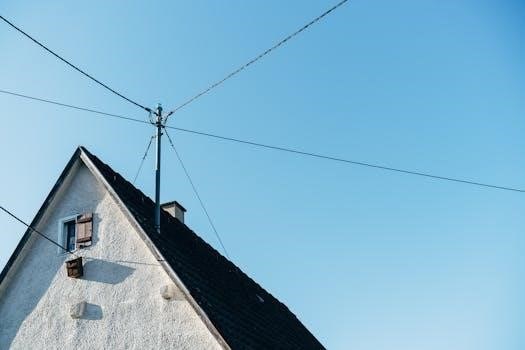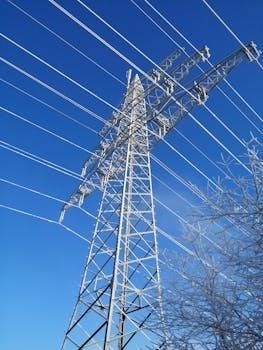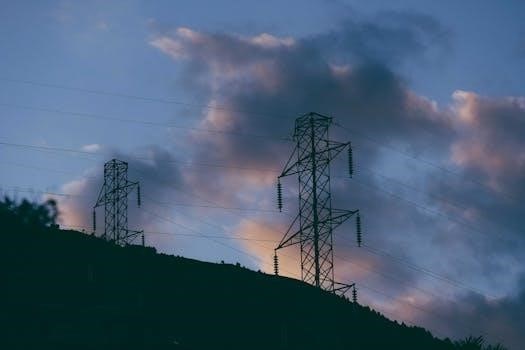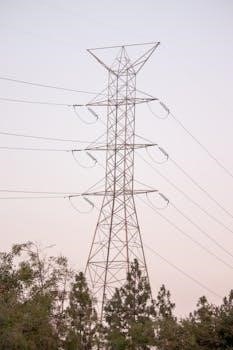
-
By:
- elizabeth
- No comment
utility pole guide wire
Utility Pole Guide Wire⁚ An Overview
Utility pole guy wires are essential components in infrastructure. They provide crucial support to utility poles, resisting external forces like wind and the weight of lines. These tensioned cables ensure stability. They prevent leaning or collapse, and are vital for maintaining reliable utility services.
Definition and Purpose of Guy Wires
Guy wires, also known as stay wires, are tensioned cables designed to provide supplemental support to utility poles. These wires counteract the forces exerted on the pole by overhead lines, wind, and ice. They are typically anchored to the ground at an angle, creating a triangular support system. This system effectively stabilizes the pole, preventing it from leaning or falling.
The primary purpose of guy wires is to ensure the structural integrity of utility poles. They distribute the load and maintain the pole’s vertical alignment. This is particularly important for poles that support heavy equipment, such as transformers, or are located in areas prone to high winds or unstable soil. Guy wires are crucial for maintaining consistent service and safety. They help to minimize the risk of power outages and accidents. They are essential for the reliable operation of power and communication networks.
Materials Used in Guy Wire Construction
The selection of materials for guy wire construction is critical to ensure strength, durability, and resistance to environmental factors. The most common material used for guy wires is galvanized steel. This is selected because of its high tensile strength and corrosion resistance. Galvanization is a process that coats the steel with a layer of zinc, protecting it from rust and degradation.
High-strength steel strands are often used for guy wires in areas with heavy loads. These strands provide additional support. Other materials, like fiberglass or synthetic fibers, are sometimes used. These are most commonly used in specific applications where electrical conductivity is a concern.
The choice of material depends on the specific requirements of the installation, including load, climate, and environmental conditions. Careful consideration ensures the longevity and reliability of the guy wire system.
Components of a Guy Wire Kit
A standard guy wire kit typically includes several essential components necessary for a complete and secure installation. The primary component is the guy wire itself. This is usually made of high-strength galvanized steel. An anchor rod is included, which is driven into the ground to provide a stable foundation for the guy wire.
An insulator is often included. This is used to prevent electrical current from traveling down the wire to the ground. Guy wraps or preforms are used to secure the guy wire to the pole and anchor rod. A thimble eye bolt connects the guy wire to the anchor rod, preventing wear and tear on the wire.
A square washer distributes the load on the anchor rod. A guy anchor provides a secure point of attachment in the ground. These components work together to ensure the guy wire system provides reliable support and stability.

Installation of Utility Pole Guy Wires
Installing utility pole guy wires requires careful planning and execution. It is important to ensure the pole’s stability. Proper anchor placement and tensioning are vital for optimal performance. Safety precautions must be followed throughout the process to prevent accidents.
Necessary Gear and Safety Precautions
Guy wire installation demands specific gear and strict safety protocols to mitigate risks. Workers must wear appropriate personal protective equipment (PPE). This includes hard hats, safety glasses, and insulated gloves. Proper footwear with good grip is essential for stability on uneven terrain. Tools must be in good working condition. Regular inspections are needed to ensure their reliability.
A wrench-down clamp can create a tamper-proof assembly. This discourages unauthorized disassembly. Awareness of potential hazards is paramount. Falling poles, snapping guy wires, and the proximity of electrical wires pose significant threats. Before starting, inspect the work area for any obstructions or potential dangers. Ensure that the pole is stable and properly supported before detaching any existing guy wires.
Effective communication among the installation team is also crucial. Clear signals and procedures should be established to coordinate movements. A designated spotter can help monitor the surrounding area for hazards. It is also important to adhere to all relevant safety regulations and guidelines.
Step-by-Step Installation Process
The guy wire installation begins with preparing the anchor point. This typically involves installing a screw anchor into the ground. The anchor’s depth and placement depend on soil conditions and the anticipated load.
Next, attach the guy wire to the pole using a guy ring and clamp. Ensure a secure connection at the specified height. The wire is then run down to the anchor point.
A turnbuckle is used to connect the guy wire to the anchor. This allows for tension adjustment. Tighten the turnbuckle until the guy wire is taut. This provides the necessary support to the pole.
Verify the mast is plumb during the entire process. Wrap the wire around itself at least six times for secure fastening. Finally, inspect all connections and the overall installation for compliance.
Proper installation is vital for the guy wire’s effectiveness and the pole’s stability.
Anchor Placement and Soil Considerations
Anchor placement is paramount for guy wire effectiveness. The anchor should be positioned at an appropriate distance from the pole base, typically at a 45-degree angle.
Soil conditions significantly influence anchor selection and installation. Soft or unstable soil requires larger or specialized anchors for adequate holding power. Rocky soil may necessitate alternative anchoring methods.
Consider the soil’s load-bearing capacity to prevent anchor pullout. Soil testing can determine the appropriate anchor type and depth. Proper compaction around the anchor is crucial for stability.
Ensure the anchor is installed within the utility easement. Compliance with local regulations is important. The anchor should be accessible for inspection and maintenance.
Effective anchor placement and careful consideration of soil conditions guarantee the guy wire system’s reliability. This ensures long-term support for the utility pole.

Function and Design
Guy wires stabilize tall structures using mechanical principles. The design balances strength and flexibility. This ensures stability against diverse loads. Proper design considers pole size, line weight, and environmental factors. Optimal function relies on well-engineered design.
Functional Roles of Guy Wires
Guy wires serve several critical functional roles in maintaining the stability and integrity of utility poles and related structures. Their primary function is to counteract the forces that can cause poles to lean, tilt, or even fall over, ensuring the reliable transmission of power and communication signals.
One of the key roles of guy wires is to provide support against wind loads, which can exert significant pressure on tall, exposed utility poles. By anchoring the pole to the ground at an angle, guy wires effectively resist the force of the wind, preventing the pole from bending or breaking.
Additionally, guy wires help to balance the weight of overhead lines and equipment, such as transformers, that are attached to the pole. These loads can create uneven stresses on the pole, potentially leading to structural failure. Guy wires distribute these loads more evenly, reducing the risk of damage.
In situations where poles are located on uneven terrain or unstable soil, guy wires provide added stability, preventing the pole from shifting or sinking. They also play a crucial role in supporting poles at corners or where lines change direction, as these points are subject to increased tension.
Design Considerations for Different Poles and Loads
Designing guy wire systems requires careful consideration of various factors to ensure optimal performance and safety. The type of pole, the anticipated loads, and environmental conditions all play a significant role in determining the appropriate guy wire configuration.
For taller poles or poles supporting heavier loads, such as multiple lines or transformers, stronger guy wires with higher tensile strength are necessary. The angle of the guy wire is also crucial, as a steeper angle provides greater resistance to overturning forces.
Soil conditions must be assessed to determine the appropriate type of anchor. In soft or unstable soil, larger or specialized anchors may be required to provide adequate holding power. The presence of underground utilities or other obstructions may also influence anchor placement.
Environmental factors, such as wind speed, ice loading, and corrosion potential, must be taken into account when selecting guy wire materials and hardware. Galvanized steel is a common choice for guy wires due to its strength and resistance to corrosion. In areas with high winds, additional guy wires or stronger anchors may be necessary.
Finally, design should adhere to industry standards and regulations, ensuring the safety and reliability of the entire utility pole system.

Maintenance and Safety
Maintaining and inspecting guy wires is crucial for safety and reliability. Regular checks identify wear, corrosion, or damage. Timely replacements prevent failures, ensuring structural integrity. Safety protocols during inspection and maintenance are paramount to prevent accidents and injuries.
Inspection and Replacement of Guy Wires
Regular inspection of guy wires is paramount for ensuring the continued stability and safety of utility poles. Inspections should focus on identifying signs of corrosion, fraying, or physical damage to the wire strands, as well as the condition of the anchors and attachment hardware.
Look for loose or missing components, and any evidence of tampering or vandalism. A comprehensive inspection should also assess the soil conditions around the anchor points, checking for erosion or instability that could compromise the anchor’s holding capacity.
The frequency of inspections should be determined by environmental factors, such as exposure to high winds, coastal salt spray, or heavy ice and snow. Replacement of guy wires is necessary when significant damage or degradation is detected.
Use industry-standard guidelines for determining when a guy wire should be replaced based on the severity of corrosion or the number of broken strands. Proper replacement procedures should be followed to ensure that the new guy wire is correctly tensioned and securely anchored, restoring the pole’s stability.

Always prioritize safety during inspection and replacement, using appropriate personal protective equipment and following established safety protocols.